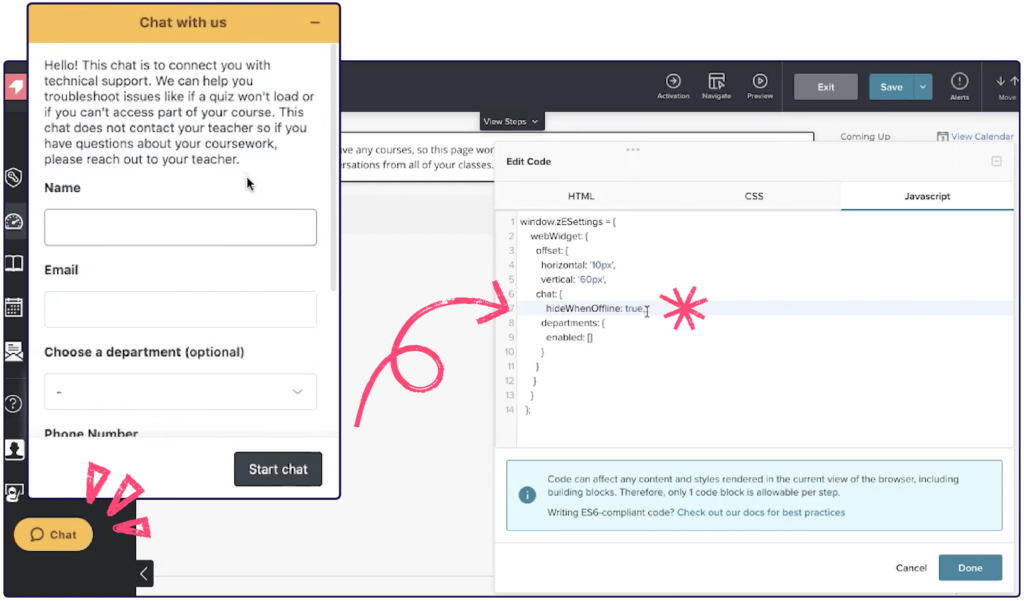The fragmented funnel
Building community is all about fostering connections. In the context of education, those connection points involve a lot of different user groups—from administrators to students. So much of the edtech experience involves managing access levels and workflows to ensure the right content gets served to the right people, at the right time. Pendo makes it easier.
StrongMind started working with Zendesk Chat in 2019. At first, they intended to only make this suite of help tools accessible to teachers and administrators. But they quickly realized that funneling support requests from the other groups StrongMind serves—including parents and students—through already-busy teachers and admins was overcomplicating the process. “If a student or a parent needed help, it would have to funnel through a teacher or admin,” said Kaly Nasiff, product owner at StrongMind. “So when a student had an issue, they had to reach out to their teacher, and then the teacher had funnel it to our customer success team. [It was like] playing telephone to solve a user issue.”
This fragmented workflow ultimately led to a large influx of tickets that needed to be addressed by StrongMind’s customer success team. “We went from a couple hundred tickets a month in 2019 to over 2,500 tickets a month in 2020,” Nasiff explained. “We realized we needed to offer schools with the highest enrollment access to Zendesk Chat—and we wanted to do it really, really quickly.” Nasiff and her team turned to Pendo in-app guides for help.
Hello, is it help you’re looking for?
Nasiff and her team decided to use a custom code block in Pendo to implement Zendesk Chat within their application. They also leveraged Pendo to create a custom segment to ensure the guide would only appear for the users they wanted to grant Zendesk Chat access to: schools with the highest enrollment.
It was also important for Nasiff and her team to have a permanent version of the guide in their staging environment so they could adjust the configuration of the guide during school hours, while the chat module was available to users. “It’s also really helpful because it allows our developers to see the chat as they’re doing work on the product,” said Nasiff. “It ensures they don’t make any changes that could negatively affect that chat.”
Another critical aspect of this in-app support functionality was to ensure it only appeared to users when StrongMind customer success agents were online and available to help. “The big thing we added was the option to ‘hide when offline,’” said Nasiff. “That means the guide only [shows up] for our students when we actually have agents online to respond to them.” This customization also proved useful to account for StrongMind’s customer success availability based on region. “We have agents in two different time zones,” Nassif explained. “We had to make sure that [the chat] is only there when users should have access to it. So if they’re contacting an agent on east coast time, for example, once five o’clock hits, that user in Arizona won’t have access to the chat anymore.”

Nassif and her team have seen incredible results so far. Since they implemented it in November 2020, the Pendo guide has received over 50 million views and deflected almost a thousand support tickets that would have otherwise been submitted by teachers and administrators. “The average length of our chats are about 11 minutes,” said Nassif. “And our CSAT (customer satisfaction) score is 87.8. Each of those chats is a ticket, or sometimes multiple tickets, that have been deflected. The data is crazy—it’s been really, really effective for us.”
This Pendo guide has also dramatically reduced the amount of time it takes StrongMind’s customer success and support teams to resolve user challenges. They’re now using their Zendesk Chat functionality to create tickets for users (which accounts for roughly 20% of the tickets they receive), which allows StrongMind’s agents to move through requests more quickly and efficiently. This change has reduced their median ticket resolution time from 72.4 hours to just 1.4 hours.
Besides the incredible numbers, Nassif also acknowledged the positive impact leveraging this Pendo guide has had on the learning experience for StrongMind’s users. “For teachers, as students are moving around in their course or they’re in the middle of a live session, they still have access to the chat. We’ve heard that’s helpful,” said Nassif. It’s also proven to be extremely helpful for students—from login issues to ensuring parents have the right levels of access. “It’s been really, really helpful with [eliminating] that kind of ‘telephone’ effect.”



